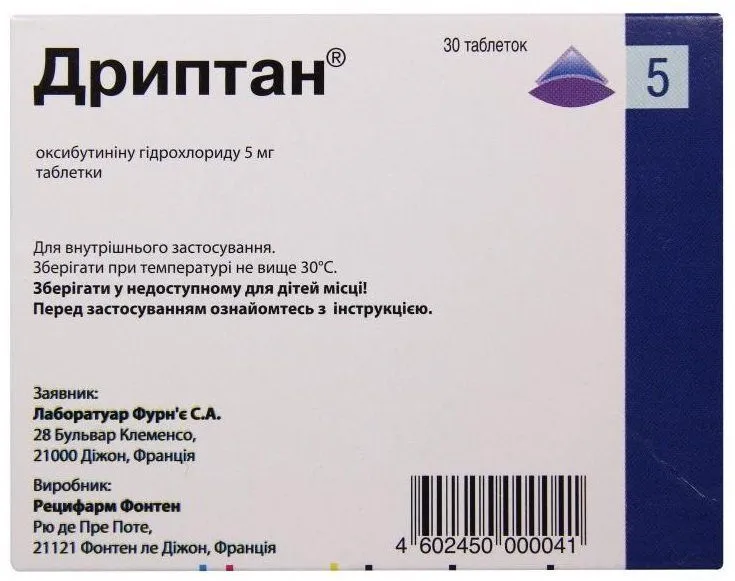Description
Driptan (Oxybutynin Hydrochloride) Tablets 5 mg. №30
Composition
Active ingredient: Oxybutynin hydrochloride.
Other ingredients: lactose monohydrate, maize starch, sucrose, talc, and magnesium stearate.
Mechanism of Action
Oxybutynin exerts its pharmacological action by competitively inhibiting the action of acetylcholine on muscarinic receptors in smooth muscle, thereby reducing detrusor muscle contractions and increasing bladder capacity.
Pharmacological Properties
Oxybutynin, the active ingredient in Driptan tablets, is an antimuscarinic agent that works by relaxing the bladder muscles.
Indications for Use
Driptan tablets are indicated for the treatment of overactive bladder, urinary incontinence, and frequent urination.
Contraindications
Do not use Driptan tablets if you have a known hypersensitivity to oxybutynin or any other component of the tablet. It is contraindicated in patients with untreated narrow-angle glaucoma.
Side Effects
Common side effects of Driptan tablets may include dry mouth, constipation, and blurred vision. If you experience severe side effects or allergic reactions, seek medical help immediately.
Usage Instructions
Adults: The usual dose is one 5 mg tablet taken 2-3 times a day. The maximum recommended dose is 20 mg per day.
Take Driptan tablets orally with water, with or without food. Do not crush or chew the tablets. Follow the dosage instructions provided by your healthcare provider.
Benefits Compared to Analogues
Studies comparing oxybutynin with other antimuscarinic agents have shown similar efficacy in the treatment of overactive bladder. However, individual responses to different medications may vary, and the choice of treatment should be based on the patient’s specific needs and tolerability.
Suitable Patient Groups
Driptan tablets are suitable for adults with overactive bladder, urinary incontinence, and frequent urination. Dosage adjustments may be necessary for elderly patients based on individual health conditions.
Storage and Shelf Life
Store Driptan tablets in a cool, dry place away from direct sunlight. Keep the tablets in their original packaging to protect from moisture. Check the expiration date on the packaging and do not use expired tablets.
Packaging Description
Driptan tablets are available in a pack of 30 tablets. Each tablet contains 5 mg of oxybutynin hydrochloride. The packaging is designed to ensure the stability and integrity of the tablets.
Clinical Evidence and Proven Effectiveness
Oxybutynin has been shown to be effective in reducing the symptoms of overactive bladder and urinary incontinence. Research published in the Journal of Urology demonstrated the efficacy of oxybutynin in improving bladder control and quality of life in patients with overactive bladder.





